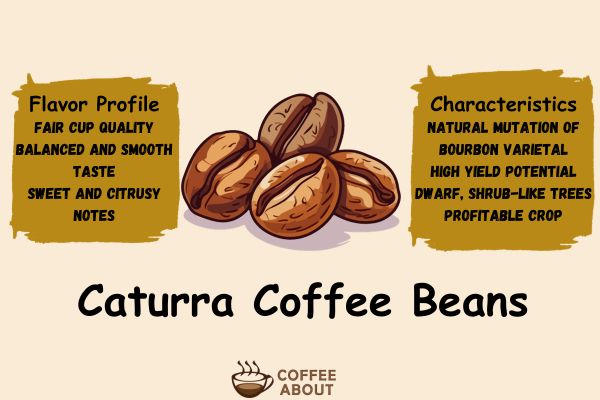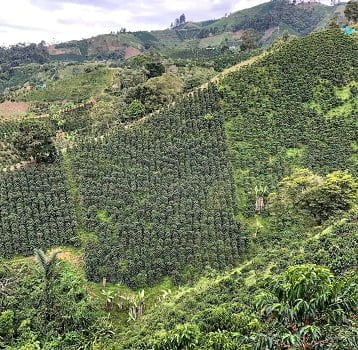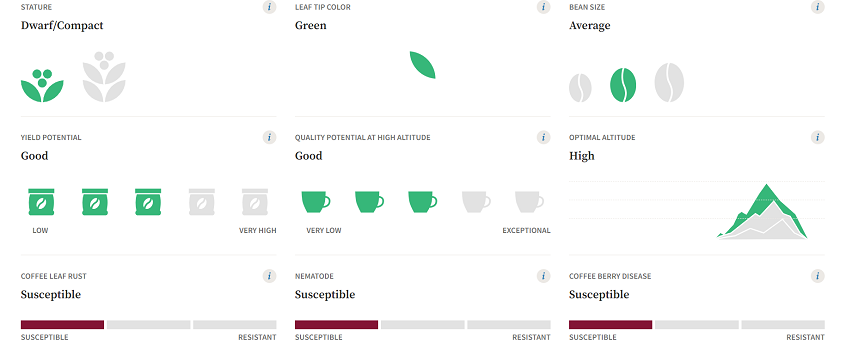Boasting high yields and hardy resilience, the commercial powerhouse Caturra Coffee has become one of the world’s most widely cultivated coffee varieties.
Caturra is a natural mutation of the Bourbon Coffee variety from the Coffea Arabica family that originated in Brazil in the early 20th century. Unlike its parent variety which is prized for exceptional cup quality but lower yields, Caturra offers farmers better yields and a fair cup quality.
While it may lack some of Bourbon’s taste complexity, Caturra delivers an appealing smooth, and balanced cup and is much more feasible economically.

Thanks to its agronomic advantages, Caturra spread rapidly across South America following its discovery. Let’s dive in and explore why this versatile coffee remains so popular among producers today.
The Origins of Caturra Coffee Plants
The Caturra coffee trees we know today first emerged back in the early 1900s in Brazil’s Minas Gerais region, arising naturally as a genetic mutation of existing Bourbon coffee plants.
Caturra’s name actually comes from a Guarani word meaning “small” – a reference to the compact and shrub-like plants of the variety.
From its birthplace in Brazil, Caturra eventually made its way to Central America when it was introduced in Guatemala during the 1940s.
From there, it spread to coffee farms in Costa Rica, Honduras, and Panama over the following decades.
Caturra became extremely popular in Colombia as well, representing up to half of the country’s coffee production at one point!
More recently, breeders have crossed Caturra with rust-resistant Hybrids and varietals to create dwarf, compact varieties that can better withstand disease and give higher yields.

Where is Caturra Coffee grown?
Caturra Coffee is commonly grown on farms across Central and South America. This rugged little shrub thrives between 1,200-2,000 meters above sea level in zones with plenty of rainfall.
Its compact form holds up well to drought, wind, and sun exposure. The variety also tolerates higher temperatures, allowing it to flourish across varied microclimates.
In recent years, Caturra has mostly been replaced by disease-resistant cultivars but it is still grown widely in the following countries:
- Guatemala
- Bolivia
- Honduras
- Colombia
- Costa Rica
- Jamaica
- Nicaragua
- Panama
- Peru

Also read: Which country has the best Coffee beans
What are the Characteristics of Caturra Coffee?
Caturra is a naturally mutated 100% Bourbon Varietal from the Arabica family with a single dwarfing gene that results in a compact, shrub-like structure. This allows the small trees to be planted more densely in farmlands, increasing overall yields per acre.

Caturra also develops very closely spaced side branches covered in fruit-bearing nodes. All this translates into impressively high productivity from the small plants, making Caturra a very profitable crop.
The variety is easily recognized by its characteristic small stature and green leaves.
For decades, Caturra’s combination of productivity and decent cup quality made it a benchmark coffee variety in Central America.
However, Caturra does have some drawbacks – its compact form is quite susceptible to pests, nematodes, and diseases like leaf rust.
Breeders have worked to overcome this by crossing Caturra with disease-resistant Timor Hybrid to create improved “Catimor” cultivars like Catuai and Maracaturra.
These retain Caturra’s signature small size and productive fruiting while adding genetic rust resistance.
What does caturra Coffee taste like?
Since Caturra originated as a mutation of Bourbon, their flavor profiles have some overlap – both produce a balanced, smooth cup. But Caturra has its own distinctive traits. The taste is often described as sweet and citrusy, with aromas of maple syrup and honey.
I’ve tried a fermented Caturra from Colombia that was delicious – rich chocolate notes paired with a smooth, non-tangy citrus accent.
While it may not have the dazzling complexity of a stellar Bourbon, Caturra still delivers a very solid cup marked by crisp, mild sweetness.
Farmers choose harvesting and processing methods like extended fermentation to refine Caturra’s mellow flavors.
The result is an accessible, crowd-pleasing coffee that highlights Caturra’s sweet spot between quantity and quality.
Discover Guides on other Coffee bean varieties
Final Thoughts
And there you have it, the full scoop on Caturra – the coffee variety that delivers solid quality alongside impressive quantity!
Caturra may not be the flashiest coffee, but it keeps the world buzzing with its dependable yields.
What do you think of Caturra? Have you tasted it before? I’d love to hear your thoughts on this humble yet mighty coffee variety in the comments.
Check out a guide on different coffee bean varieties
FAQs
What is the difference between Caturra and Catuai coffee?
Caturra and Catuai Coffee beans are both part of the Arabica Coffee family but have some differences.
Caturra originated as a natural mutation of Bourbon while Catuai was artificially created by crossing Mundo Novo and Caturra at a research institute in Brazil.
Caturra offers a balanced and smooth flavor while Catuai has a bright, acidic taste with bitter notes.
What is the difference between Yellow and Red Caturra?
Yellow Caturra and Red Caturra refer to color variations of the Caturra coffee variety. While identical in terms of plant, growth habit, and flavor, they differ in the color of the coffee cherry.
The yellow cherries mature faster and can be selectively harvested earlier compared to red cherries





